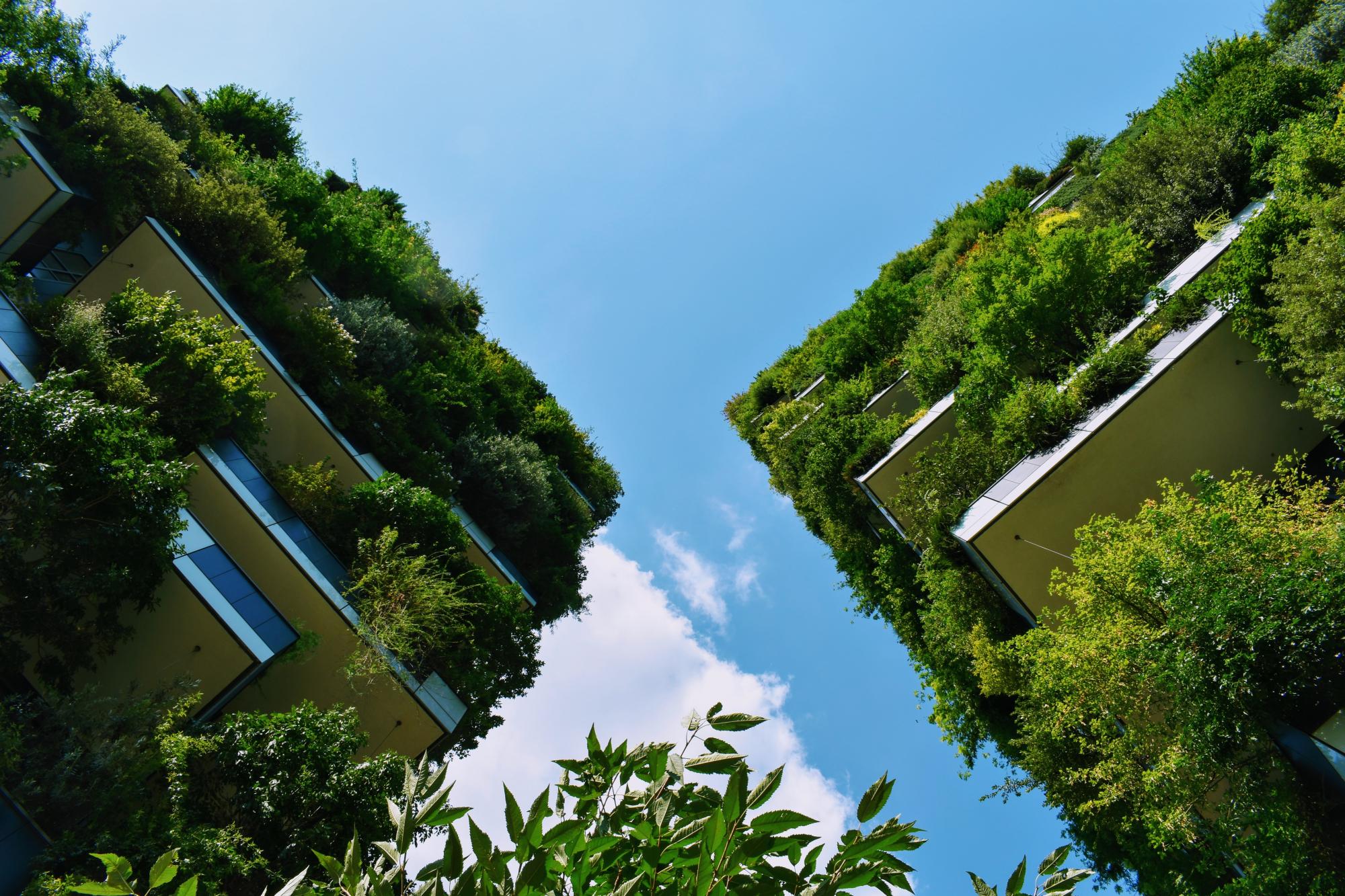Last updated: October 2021
In 2008 the new building of the WGV-Insurance has been opened in Stuttgart. Since then customers and employees of the WGV have enjoyed the beautiful courtyards which contribute to a good working environment. The approx. 3.6 ft. (1.1 m) high, built-in planters have been provided with an automatic irrigation system with the irrigation pipes installed below the elevated concrete slabs. The four courtyards have been planted with a total of 58 small crowned trees. In addition, several extensive green roof areas of approx. 21,600 sq. ft. (2,000 m²) total were installed to improve the Stuttgart climate. (1, 6).
Overview
Nature-based solution
- Nature on buildings (external)
- Green roofs
- Grey infrastructure featuring greens
- Other
Key challenges
- Climate action for adaptation, resilience and mitigation (SDG 13)
- Climate change mitigation
- Green space, habitats and biodiversity (SDG 15)
- Green space creation and/or management
- Environmental quality
- Air quality improvement
- Health and well-being (SDG 3)
- Improving mental health
- Creation of opportunities for recreation
Focus
Creation of new green areas
Project objectives
1. Reduce air conditioning costs (5)
2. Create a windbreak, reducing chill (5)
3. Reduce heating demands in winter (5)
4. Creating a good working environment (6)
5. Increase aesthetic appreciation of the company's office spaces (6)
6. To improve urban air quality (5)
Implementation activities
1. Installation of the Stabilodrain® SD 30 elements in an inner courtyard (1)
2. Installation of automatic irrigation system for plants growing (6)
3. Increasing the surface roughness of the building's roof (for a reduction in local wind velocities) (5)
Climate-focused activities
Climate change mitigation:
- Install vertical or horizontal artificial surfaces that help with carbon storage and cooling
Main beneficiaries
- Private sector/Corporate/Company
- Citizens or community groups
Governance
Management set-up
- Led by non-government actors
Type of initiating organisation
- Private sector/corporate actor/company
Participatory approaches/ community involvement
- Unknown
Details on the roles of the organisations involved in the project
Architecture/Design of the roof garden was completed by Kunder³ Landscape Architecture (Stuttgart) with a contribution by Uecker + Pfaff GmbH, Stuttgart and Garten Moser GmbH & Co. KG, Reutlingen. The green roof technological systems were installed by the ZinCo Company. Project Customer - WGV Insurance. (1, 3)
Project implemented in response to ...
... an EU policy or strategy?
Yes
(1. Guidelines for the Planning, Construction and Maintenance of Green Roofing – Green Roofing Guideline (The Landscape Development and Landscaping Research Society e. V. (FLL)) (7)
2. Recommendations for the Planning and Construction of Traffic Areas on Buildings
(The Landscape Development and Landscaping Research Society e. V. (FLL)) (7)
3. Eurocode 1 (EN 1991) Actions on structures
- Part 1-1: Densities, self-weight, imposed loads for buildings (EN 1991-1-1)
- Part 2: Traffic loads on bridges (EN 1991-2) (7)
4. Eurocode 2 (EN 1992) Design of concrete structures
- Part 1-1: General rules, and rules for buildings (EN 1992-1-1) (7)
)
... a national policy or strategy?
Yes
(1. Waterproofing of buildings - German Standard DIN 18195 (7)
2. Regulations for Roofs with Waterproofing – Flat Roof Guideline (Organization of German Roofer Society ZVDH) (7)
3. A number of guidelines, technical bulletins and additional technical contract terms of the German Road and Transportation Research Association (FGSV) (7)
4. The Federal Nature Conservation Act requires mitigation for the ecological impact of building construction. This means that green roofs are often required by conditions attached to construction permits (5).)
... a local policy or strategy?
Yes
(Since 1986, the local government has required any new building with a roof pitch below 12 degrees to be equipped with a green roof – a regulation that was extended in 1993 to encompass all new buildings (7). )
Financing
Total cost
Unknown
Source(s) of funding
- Public local authority budget
- Corporate investment
Type of funding
- Direct funding (grants, subsidies, or self-financed projects by private entities)
Non-financial contribution
No
Impacts and Monitoring
Environmental impacts
- Climate change
- Lowered local temperature
- Reduced emissions
- Enhanced carbon sequestration
- Green space and habitat
- Increased green space area
Economic impacts
- Reduce financial cost for urban management
Socio-cultural impacts
- Social justice and cohesion
- Improved access to urban green space
- Health and wellbeing
- Improved mental health
Type of reported impacts
Achieved impacts
Presence of formal monitoring system
Unknown
Presence of indicators used in reporting
No evidence in public records
Presence of monitoring/ evaluation reports
No evidence in public records
Availability of a web-based monitoring tool
No evidence in public records
References
1. (2017). ZinCo Green Roof Projects. Available at: Source link. Accessed on 14th September, 2020.
2. (2014). Green Roof of the Year 2014, Available at: Source link. Accessed on 14th September, 2020.
3. Greenroof. (2018). WUERTTEMBERGISCHE GEMEINDEVERSICHERUNG A.G. (WGV), HEADQUARTERS. Available at: Source link. Accessed on 14th September, 2020.
4. Project Profile Data WGV-Insurance, Stuttgart, Germany. Available at: Source link. Accessed on 14th September, 2020.
5. (2003). Green Roofs: their existing status and potential for conserving biodiversity in urban areas. English Nature.
6. (2016). Planning Guide. Walkways and Pathways on Roofs and Decks. ZinCo GmbH.
7. (2017). ICLEI Briefing Sheet - Nature-based Solutions, Source link. Available at: Accessed on 14th September, 2020.
2. (2014). Green Roof of the Year 2014, Available at: Source link. Accessed on 14th September, 2020.
3. Greenroof. (2018). WUERTTEMBERGISCHE GEMEINDEVERSICHERUNG A.G. (WGV), HEADQUARTERS. Available at: Source link. Accessed on 14th September, 2020.
4. Project Profile Data WGV-Insurance, Stuttgart, Germany. Available at: Source link. Accessed on 14th September, 2020.
5. (2003). Green Roofs: their existing status and potential for conserving biodiversity in urban areas. English Nature.
6. (2016). Planning Guide. Walkways and Pathways on Roofs and Decks. ZinCo GmbH.
7. (2017). ICLEI Briefing Sheet - Nature-based Solutions, Source link. Available at: Accessed on 14th September, 2020.


